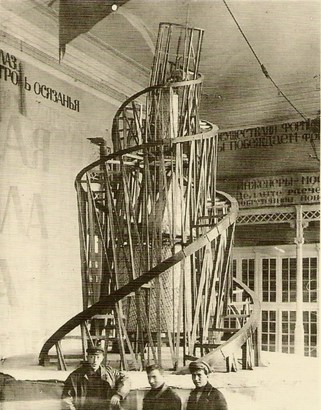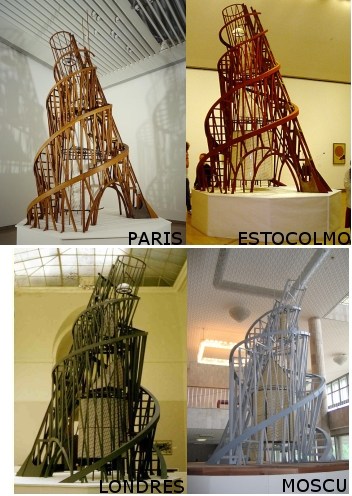 So I'm slowly making my way through the 35-page press release [!! those were the days, right?] for MoMA's 1968-9 exhibition, "The Machine As Seen At The End Of The Mechanical Age," which included a long-lost, recently stumbled-upon in a Tempe, Arizona shed, Dymaxion Car, and curator Pontus Hulten's freshly researched and replicated magnum opus, a life-size model of Vladimir Tatlin's 1920 Monument To The Third International. Some choice excerpts on the remaking of:
So I'm slowly making my way through the 35-page press release [!! those were the days, right?] for MoMA's 1968-9 exhibition, "The Machine As Seen At The End Of The Mechanical Age," which included a long-lost, recently stumbled-upon in a Tempe, Arizona shed, Dymaxion Car, and curator Pontus Hulten's freshly researched and replicated magnum opus, a life-size model of Vladimir Tatlin's 1920 Monument To The Third International. Some choice excerpts on the remaking of:
Work was based on only four photographs (a crucial one was discovered during the process), a few drawings, some written descriptions and information from the sole living assistant of Tatlin. Troels Andersen, Ulf Linde and Per Olof Ultvedt of the Stockholm Academy of Art prepared a small wooden working model. From this, carpenters Arne Holm and Eskil Nandorf built the reconstruction, which is 15 feet 5 inches high, about the same size as Tatlin's.So many interesting things here. Andersen had been working with T.M. Shapiro, part of a group called the "Creative Collective," which included Tatlin, who made the first Monument in 1919-20, to document and resuscitate [to use Nathalie Leleu's term] the neglected/suppressed history of the Russian Avant-Garde. In the catalogue, Hulten wrote, "For the first time, it seemed possible that an artist-engineer materializes the synthesis of architecture and sculpture."The research and reconstruction took about a year. The tower was first exhibited in the Tatlin show at Moderna Museet in Stockholm last summer. It was shipped to the United States in nine crates and reassembled by Mr. Nandorf in the Museum Garden.
Leleu took a detailed look at contemporary curators' use of refabrications and replicas; the excerpt dealing with reconstructions of Tatlin's Monument was published in 2007 by Tate Papers.
She notes how Hulten was "a major protagonist in at least two of these reconstructions," the first at Moderna Museet in 1968, and then at the Pompidou in 1979 for his historic show, Paris-Moscow. The Paris model was substantially different from the Stockholm model, Leleu writes, in part because Shapiro had recovered additional notes and rebuilt a Monument himself in 1975, but also because by 1979, Hulten was able to access original Tatlin materials in Russian museums and archives which had previously been blocked.

In fact, because of last-minute denials of key loans by Soviet officials, Hulten's show in 1968 consisted entirely of reconstructions, which led Hulten to dub his show "conceptual." As it happens, this whole Tatlin saga and the fabrication of the Monument, was unfolding while the Moderna Museet was showing Andy Warhol's work--including the Brillo Boxes, which would eventually become the subject of their own refabrication controversy.
It's almost as if, while showing the dominant, if controversial, figure in American art, Hulten was simultaneously constructing an alternative to the arc of modernist and postwar art history. With an emphasis on the constructing, I guess.
Anyway, after an insurance dispute, the Parisian fabricators ended up making a new, Paris-style Monument for the Moderna Museet, and then consulting, along with Hulten, on the fabrication of additional Monuments in Moscow, one in London, and one in Los Angeles.
Maybe it's clearer in her fuller paper, but in the Tate excerpt, Leleu refers to a "reconstruction project...in Washington," which I think is actually the model built by USC Architecture School students for Maurice Tuchman's LACMA 1980 exhibit, "The Avant-Garde in Russia," which later traveled to the Hirshhorn.
The Model of Vladimir Tatlin's Monument to the Third International: Reconstruction as an Instrument of Research and States of Knowledge [tate papers 2007]












